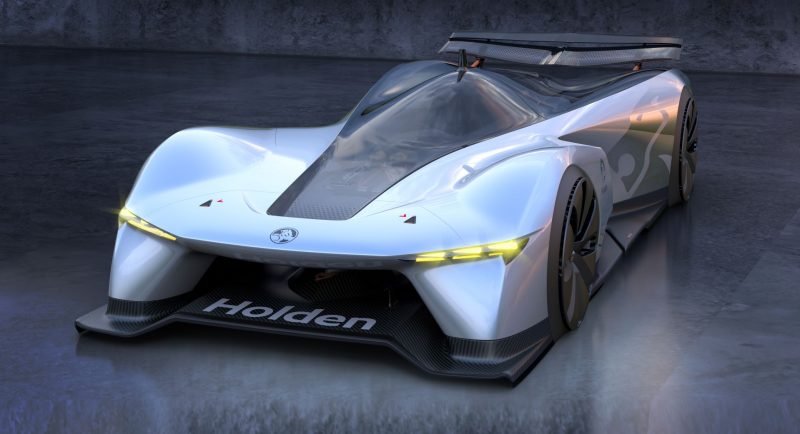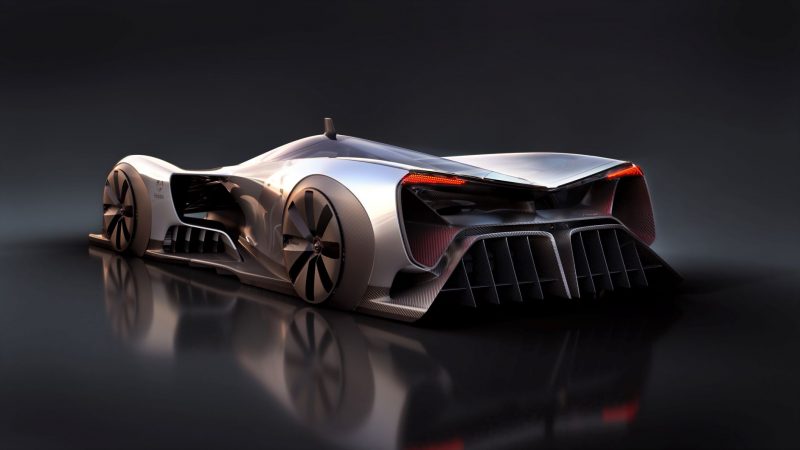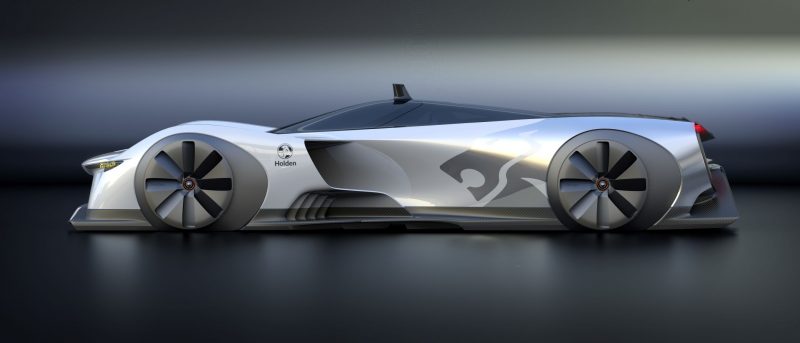
GM Holden has designed a radical time attack concept race car to coincide with the 50th anniversary of the marque’s first Bathurst win in 1968.
Conceived by GM Holden’s design team, the car was developed entirely virtually, using sophisticated simulation technology and driven by the world-class expertise within its Melbourne design studio.
Holden has focussed the design around achieving pure one lap pace with the company claiming the concept could theoretically lap Mount Panorama in 1:29.30s, more than 30 seconds faster than the current outright lap record, and reach speeds of 480km/h.
The entirely carbon fibre chassis is powered by four 254kW electric motors which could produce 1340 horsepower.
It was developed with technical input from GM Holden’s engineering team and the final design was validated with a digitally-printed 3D model.
“The technology we employ today has transformed the way we design cars,” said GM Holden’s Design Director, Richard Ferlazzo.
“We have the ability to simulate a car’s appearance, technology and dynamics in convincing animations, which enables us to deliver better designs in a shorter time.
“A large part of our work is Advanced Design and we use this technology to develop concept designs for our parent company, General Motors.
“This concept is a digital advertisement for the advanced skills, capability and technology of the GM Holden team.”
Fans will get to see a virtual lap being completed by the car during Saturday’s broadcast from the Supercheap Auto Bathurst 1000.
This weekend’s race sees Holden celebrate a maiden Bathurst victory delivered by Bruce McPhee and Barry Mulholland in an HK Monaro back in 1968.
Holden Concept Technical Specifications
Weight:
900 kilograms (without driver)
Performance:
Simulated Mount Panorama Lap Time: 1:29.30
0-100km/h: 1.25 sec
Top Speed: 480km/h
Maximum Lateral G-Force: 6.5G
Maximum Braking G-Force: 6G
Powertrain:
Motors:
250kW Axial Flux Permanent Magnet Electric Motor Drives x 4 (Inboard mounted)
Total output – 1000kW (1Megawatt) / 1340HP
3240Nm Total Motor Torque
5000RPM Maximum Revolutions
Enables full programmable Torque Vectoring Traction Control at each corner
Gearboxes:
3-Speed Planetary Automatic Shift Gearboxes x 4
Ratios 1st 2.97:1, 2nd 1.7:1, 3rd 1:1
First gear ratio enables 9620Nm total axle torque at launch
Gearbox casing integrated into Chassis structure
Power Source:
Reconfigurable Graphene Hybrid Power Pack
1MW power output, 90MJ Usable Charge Capacity
Fast Recharge: Fully recharged in 90 seconds (1000kW, 800V, 1250A)
Motor Cooling:
Longitudinal Heat Exchangers x 2
Liquid-to-Gas Phase Change Cooling, low drag, full pass-through
Brakes:
Carbon/Carbon Hydraulic Discs x 4
Electrical Heating of pad and rotor in pits and on out-lap to conserve energy
Full Regenerative capability on all axles, can provide up to 2.0G braking force
Structure:
Chassis:
Carbon Fibre composite with cellulose Honeycomb Core
Full Integrated safety cell and crash structure, utilising stressed powertrain components
Suspension:
Carbon Fibre Double Wishbone all-round, aerodynamically engineered profiles
Titanium CNC’d Uprights with bushed underbody mounts
Pushrod / bellcrank activated Hydraulic Active Suspension Actuators. Computer controlled programmable ride height adjustment, anti-dive, anti-squat, anti-roll
Electric Power Steering
Body:
Carbon-Fibre/Kevlar Composite panels with Polycarbonate Graphene Coated Upper
Underbody:
Full Carbon Fibre / Kevlar Composite quad-venturi underbody, with flexible co-moulded membranes at Body and Chassis junctions
Underbody is structurally mounted to Suspension uprights at all 4 corners, enabling full aero load to be applied directly to each wheel
Torsional twist capability enables underbody to maintain consistent relationship to ground even with extreme road camber change
Wheels:
310/700 R18 Slick tires all round
Carbon Fibre Composite Rims
Active Wheel Fairings support low drag or brake cooling positions
Wheel Fairing supported by a Kevlar/Elastane woven skin enabling consistent low drag performance whilst supporting full wheel steering and suspension movement
Aerodynamics:
Low Frontal Area with all powertrain components on centre-line in Driver’s frontal area ‘shadow’
Full Active Downforce Generation via Ground Effects technology
Ultra-high Downforce levels achieved via electrically powered Cyclo-gyro fans
Rubber Skirts control air-bleed and enhance Ground Effect
4 Individually controllable Fans accelerate airflow through 4 venturi tunnels to enhance downforce at lower speeds
Fans enable programmable and constantly tuneable centre-of-pressure
Cyclo-gyro fans with actuated blades enabling variable thrust direction and force
Fans powered by 4 Switch Reluctance Motors (SRM), each up to 50kW, 50,000rpm, 92% efficient
Hydraulically actuated variable-position rear wing with air-braking capability
Lift-drag Ratio of underbody aero components in excess of 90:1
Miscellaneous:
Front Lighting:
Active Matrix Laser Units with yellow ‘Endurance’ Tint
Rear Lighting:
LED Matrix display – programmable pixels
Driver Assistance:
Augmented Reality Helmet: 3D graphics projected onto helmet visor to enable graphics overlay in real-time. Essential technical information provided in addition to racing line and braking zone benchmarks.
Integrated full steering wheel inputs to control all mechanical and aerodynamic systems via presets.
Six Point safety harness.
Telemetry and Camera mast to enable constant uplink and data transmission and in-car filming






















Discussion about this post